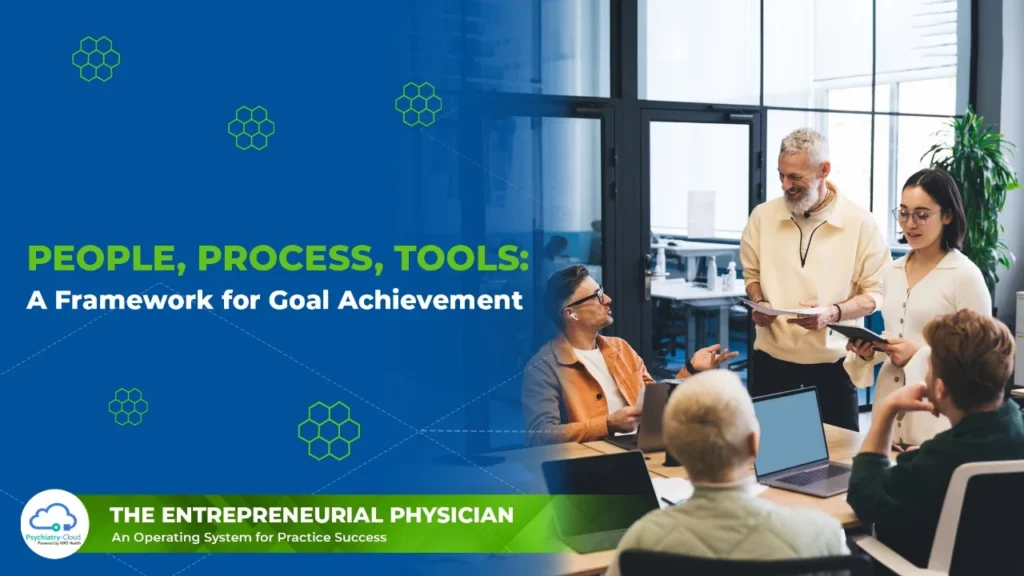If you’re serious about achieving goals, you need more than just good intentions; you need a robust action plan. This plan should allow you and your team to see progress through ongoing measurements, not just at the end of a month, quarter, or year.
Process: Outline the step-by-step process to achieve your goal. Detail all dependencies and interconnections.
People: Identify who is responsible and the roles that are required. What skills and training do the people involved need?
Tools/Tech: Determine the necessary tools and technologies for this process. Is your tech stack straightforward or complex? Are your actions measurable? Can you automate parts of your process for efficiency?
Here is an appointment confirmation example:
Goal: No fewer than 90% of appointments are confirmed at least 24 hours before the appointment, as measured by a monthly retrospective review.
Let’s first look at a constrained system that is unlikely to achieve that goal.
- Process: First, define the process for achieving the goal. In this case, let’s assume you are using a human-resource-dependent process, which is to have your front desk call each patient one week prior to the appointment.
- Tools/Tech Stack: Based on the process described above, all you might need is a phone, an appointment scheduling system to determine the appointments that require confirmation, and a place to log the call results.
- People: A front desk-trained person.
Here’s why this won’t approach work:
If you approach this problem by solely assigning human resource time, you will hit a limit on the number of confirmation events possible in a work day. A system like this is challenging to scale and maintain. Also, you have set up a system where there is a dependency that the patient or patient-representative is available to answer the phone when your staff calls to confirm the appointment.
Not only are there two human points of failure, but the process is mostly unauditable or not easily measured and improved. It also leads to other process questions, such as: When does this process begin? What is the process for communicating the confirmation event? And what happens when the person making the phone calls is out sick? Who exactly is making the phone call? Are they trained on the correct script? If there’s a human dependency, then what happens when that person doesn’t show up for work? If you employ someone solely to handle phone calls, what other tasks should they be completing? How will you know if they are doing a good job?
In a human-dependent process, you face challenges that may lead to recidivism or only short-term goal attainment.
Now, let’s describe an appointment confirmation process where there is automation, fault tolerance, measurability, scalability, and overall manageability.
Appointment Confirmation Automation
- Process Automation: One week prior to a scheduled encounter, an appointment confirmation reminder is sent via SMS and/or email, directing the patient to confirm or cancel the appointment. Patients must enter pre-encounter clinical and demographic information in the patient portal during this process. A repeat automated reminder occurs 24-48 hours before. When there is no response, we coordinate automated communications using SMS, email, and automated phone reminders. For those patient subsets that do not respond in this automated manner, a staff member calls the patient directly the day before the appointment.
- Tool/Tech Stack: The tool or tech stack supporting this process is a practice management/EMR platform that has the scheduler connected to an automated process, as described above. Reporting is also necessary to identify outlier patients who were not confirmed by the automated process.
- Person/Role: A staff member charged with appointment confirmation who is able to use the described reports, but whose job it is to manage the outliers rather than the entire task of appointment confirmation.
Imagined this way, we can also look at our prior constructs of entrepreneur, manager, and technician.
The entrepreneur’s role is to imagine the system described above and create a strategic plan for building it.
The manager’s responsibility is to guarantee the system’s functionality by overseeing the operation of the process, the tech stack, and the training and accountability of the system’s personnel towards performance goals. Furthermore, the manager reviews monthly reports, ensures that goals are attained, determines any issues with the process, the tech stack, or the persons involved with the process, and takes corrective action.
Finally, the persons (technicians) involved need to have the proper skills, training, and accountability to achieve their goals.
Understand that goal attainment hinges on people, processes, and tools. This breakdown helps you pinpoint how to get things done and diagnose why goals might not be achieved. Think of people, processes, and tools as the core components of your “system” for goal attainment.
As we move forward, we’ll explore what makes a system well-run and how to know when your system is optimized.
Boost Your Practice’s Financial Health with Our Expert KPI Guide.









